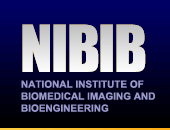Home > Research > NIBIB Intramural Labs Positron Emission Tomography Radiochemistry GroupContentsResearch EmphasisThe primary research focus of this group is the development of radiopharmaceuticals labeled with positron emitting radionuclides for the purpose of conducting human imaging using positron emission tomography (PET). PET is a powerful technology capable of imaging biochemical processes in vivo (i.e., receptor interactions). Development of novel specific radioligands for PET may lead to an enhanced understanding of various biochemical processes and breakthroughs may lead to development of new therapeutic drugs. PET imaging agents for the study of neurological disorders (i.e., muscarinic, serotonergic, and corticotropin releasing hormone (CRH) ligands) and cancers (i.e., biologically active peptides and chemotherapeutic agents) have been evaluated for their potential utility for human clinical protocols. During the past several years, our group has successfully developed selective radioligands for serotonin 1A (5-HT1A) receptor and M2 (muscarinic subtype 2) receptor.
In the M2 field, we have prepared the muscarinic radioligand, {[18F]FP-TZTP], which is a chemical modification of a known muscarinic agonist. Using knock-out mice, we established that the compound displays M2 selectivity in vivo. Additional studies suggest that the binding selectivity is dependent on the kinetic off-rate difference among the muscarinic receptor subtypes. This compound, now under an approved investigational new drug application (IND), is involved in human use protocols in the CC PET Department. The compound is synthesized by the PET Department Radiochemistry Group and used by researchers in the National Institute of Mental Health in studies in depression and Alzheimer’s Disease.
Based on an earlier compound, WAY-100635 developed at Wyeth Ayerst, we synthesized a number of antagonists containing Fluorine-18. Because of the distribution of 5-HT1A receptors, the relative receptor affinity is easily determined by comparing radioactivity accumulated in the hippocampus to that of the cerebellum. As a result of this work we have pursued two compounds, one (FCWAY) has quite high affinity and thus should be best suited to PET measurement of receptor concentration and a second compound ([18F]FPWAY) of somewhat lower affinity that may be useful in assaying endogenous serotonin concentrations. [18F]FCWAY is used in the Clinic under IND by investigators in both NIMH and NINDS in human-use protocols.
ResourcesWe obtain radionuclides from the Cyclotron Facility of the Positron Emission Tomography Department, Warren Grant Magnuson Clinical Center. The Cyclotron Facility operates three cyclotrons with capabilities for producing several radioisotopes useful for Positron Emission Tomography. Our facilities are equipped to conduct radiolabeling procedures with Fluorine-18 and Bromine-76. In addition, we have expertise in conducting pre-clinical studies using in vitro and in vivo techniques including biodistribution, metabolism, and autoradiography. We have chemical synthesis and chemical analysis capabilities (Nuclear Magnetic Resonance Spectroscopy, High Performance Liquid Chromotography, Gas Chromatography, and Mass Spectrometry).
Collaborative OpportunitiesWe are interested in discussing collaborations that make use of our expertise. In particular, we wish to discuss biological problems that can be investigated using an appropriate radioligand and PET imaging in animals and/or humans.
Training OpportunitiesOpportunities are available for summer positions at the college level or above. To learn more about the various NIH programs, visit http://www.training.nih.gov/student/index.asp.
Postdoctoral Intramural Research Training Awards (IRTAs) are also available. Infomation is available at http://www.training.nih.gov/postdoctoral/irta.asp.
Opportunities are available for international students through the visiting fellow (VF) program. More information, including a listing of openings, is available at: http://www.training.nih.gov/postdoctoral/vf.asp. Further information is available from the NIH Division of International Services.
We encourage inquiries by recent Ph.D. graduates in organic, medicinal, or radio chemistry; pharmacology; or molecular imaging. For more information about training opportunities in our laboratory please contact D. Kiesewetter.
Selected Publications
|
 |
 |
Department of Health and Human Services |
 |
National Institutes of Health |
 |



